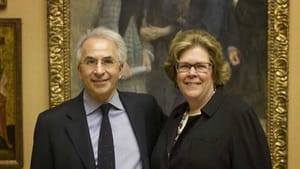Stay in the Loop
BSR publishes on a weekly schedule, with an email newsletter every Wednesday and Thursday morning. There’s no paywall, and subscribing is always free.
The Barnes confronts a rock and a hard place
Derek Gillman departs

The saga of the Barnes Foundation took a new turn this month with the announced resignation of Derek Gillman, the director who had presided over the move of its collection from Merion to Center City. The parting came with none of the usual expressions of mutual esteem between employer and employee. Gillman said he was leaving a post that had paid him approximately the salary of the President of the U.S. for a visiting professorship at Drexel University’s Westphal School of Media Arts. The faculty at Westphal, I am told, was as surprised by the appointment as was everyone else.
A reliable source tells me that Gillman was fired when the Barnes board learned that the foundation had incurred a multimillion-dollar deficit for the 2012 fiscal year. That Gillman was replaced on an interim basis by board member Margaret Zminda, who among other things is the Barnes Foundation’s chief financial officer, suggests a circling of the wagons.
Other issues may have been involved, of course. But Gillman had exposed himself with a preposterously implausible projection of the Barnes’s revenues in Center City in a 2010 Inquirer op-ed that may have set him up for his fall. (To see the analysis of this projection by Tom Freudenheim and myself in BSR, June 2011, click here.)
Budget gap
Still, if the fact that the Barnes is already awash in red ink was a genuine surprise to the foundation’s trustees, then they should have resigned en masse themselves. The recent admission increase from $18 to $22 and the desperate efforts to rent the new hall to any conceivable cultural venue or private party was signal enough to the general public that the Great White Hope on the Parkway was bailing fast. Even though the Barnes allegedly exceeded its own projected first-year attendance by 30 to 60 percent in its first year of operation with 325,000 visitors— a figure I take with the same grain of salt that experience has taught me to do with every number emanating from the Barnes in the past 20 years— and even if every customer paid top dollar, the budget gap would still have remained. And the Barnes’s first year, with its downtown novelty still fresh, must be considered almost certain to be fiscally its best.
A decent interval is needed before the new Barnes collapses into the waiting arms of the Philadelphia Museum of Art. The Barnes estate in Merion would fetch perhaps $12 million, and the non-gallery collection, unprotected by indenture, might bring twice that amount. The wall ensembles that attempt to replicate the spatial configuration of the old Merion galleries could be broken up to utilize the new museum space and accommodate more visitors (this may have been envisioned from the beginning in designing a facility with eight times as much space as the original in Merion).
What Scott told Glanton
But the only way to sustain the Barnes over the long run is to start selling off the gallery collection. This option has so far been forbidden, as has been the dismantling of the wall ensembles. At such a point the Art Museum could rush in to “save” the Barnes by taking it over.
The late Art Museum president Robert Montgomery Scott reportedly once told Richard Glanton, who ran the Barnes, that it was only a matter of time before the At Museum acquired its art. The wheels were soon set in motion— in part by Glanton himself, despite the posture he now assumes of having tried to save the Barnes in Merion— and they are running smoothly toward that goal. It’s a Tinker-to-Evers-to-Chance theft, with the Barnes Museum in the keystone position and Derek Gillman serving as the Johnny Evers standing on second base. It turns out, though, that he was only a runner waiting to be picked off.
Sign up for our newsletter
All of the week's new articles, all in one place. Sign up for the free weekly BSR newsletters, and don't miss a conversation.
 Robert Zaller
Robert Zaller